Potential for Underground Storage of Liquid Fuels in Bedded Rock Salt Formations in Poland
Abstract
:1. Introduction
2. Materials and Methods
2.1. Research Area
2.1.1. Bedded Rock Salt Formation in the Northern Part of the Zechstein Basin
2.1.2. Bedded Rock Salt Formation in the Fore-Sudetic Monocline
2.2. Methods for Assessing the Storage Capacity of the Rock Salt Layer
- strategic reserves caverns, rarely emptied, and only with saturated brine;
- operational storage caverns, intended to be emptied several times with water or brine of low concentration.
3. Theoretical Background of the Methodology
3.1. Cavern Size
3.2. Cavern Spacing
3.3. Initial and Final Cavern Size
3.4. Rock Salt Storage Capacity
3.5. The Impact of Convergence on the Storage Cavern Capacity
3.6. Calculations and Storage Capacity Map Development
- Δht—thickness of the rock salt over the cavern—45 [m];
- Δhn—length of the cavern neck—15 [m];
- Δhb—thickness of the rock salt below the cavern—5 [m];
- Dmax—maximum cavern diameter—67 [m];
- Δhlim—the height of the residual brine zone—40 [m];
- L—cavern spacing modulus—200 [m];
- hmax—maximum depth of the rock salt layer top—1800 [m];
- Mmin—minimum rock salt layer thickness—130 [m];
- Din—coefficient of diameter increment—0.25 for strategic storage facilities; 0.08 and 0.2 for operational storage facilities, in the case of initial and target conditions, respectively;
- Tm0—rock mass temperature on the ground level—285 K;
- gT—geothermal gradient—0.01 K/m and 0.027 K/m in northern and southwestern Poland, respectively.
4. Results
4.1. Rock Salt Storage Capacity in Northern Poland
4.2. Rock Salt Storage Capacity in the Fore-Sudetic Monocline
5. Discussion
6. Conclusions
Author Contributions
Funding
Data Availability Statement
Conflicts of Interest
Appendix A. Determination of Liquid Fuels Storage Cavern Safe Spacing
- caverns are arranged in a triangular grid;
- caverns are filled with the stored medium, i.e., the brine level is at its deepest point;
- the average vertical pressure in the rock mass results from the weight of the rocks, minus the counterpressure of the stored medium;
- the stored medium counterpressure is attributed to the cavern roof, and the influence of the shape of the cavern dome is neglected;
- the least favorable conditions occur at the brine/stored medium interface depth;
- the case is considered when the cavern is under the stored medium column pressure (such an extreme case may occur due to a failure).
| Stored Media | Polynomial Intercept | Coefficient | Coefficient |
|---|---|---|---|
| Crude oil | 2.41 | 0.000514 | 9.63 × 10−8 |
| Gasoline | 2.51 | 0.000410 | 3.33 × 10−7 |
| Brine | 2.35 | 0.000340 | −4.7 × 10−6 |
| LPG | 5.17 | 0.005991 | 4.67 × 10−6 |
Appendix B. Thickness and Top Depth Maps of Bedded Salt Deposits in Poland
Appendix B.1. The Northern Part of Poland
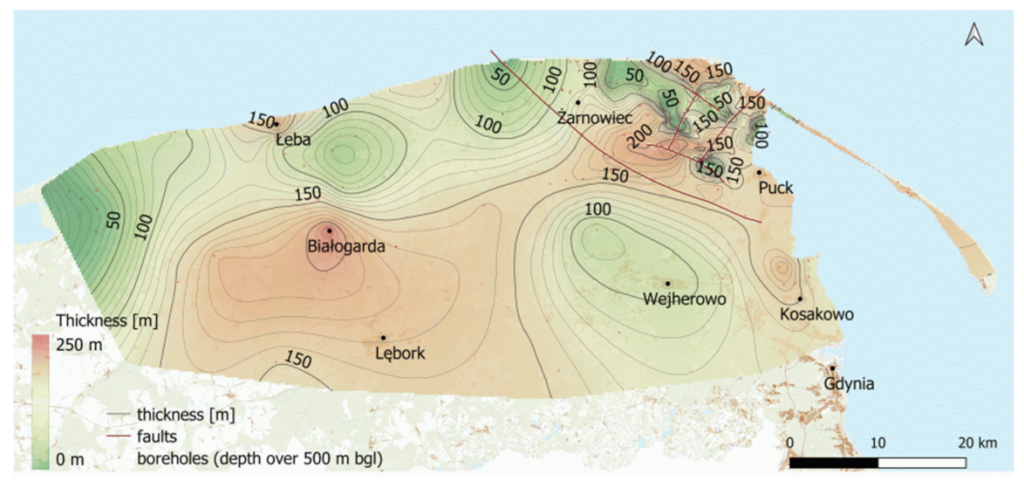
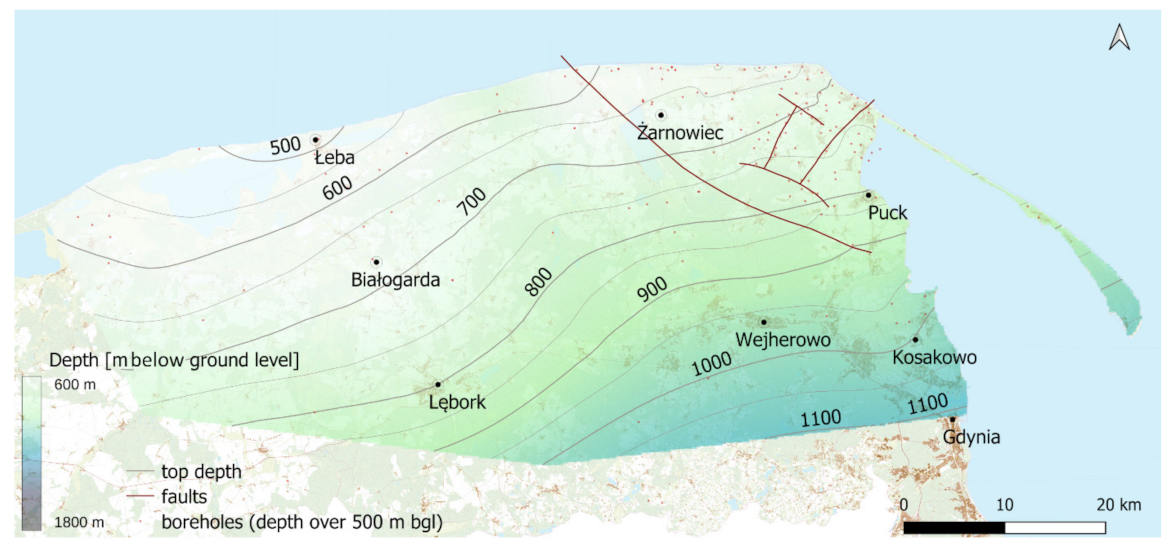
Appendix B.2. The Fore-Sudetic Monocline


Appendix C. Storage Capacity Maps
Appendix C.1. The Western Part of the Fore-Sudetic Monocline
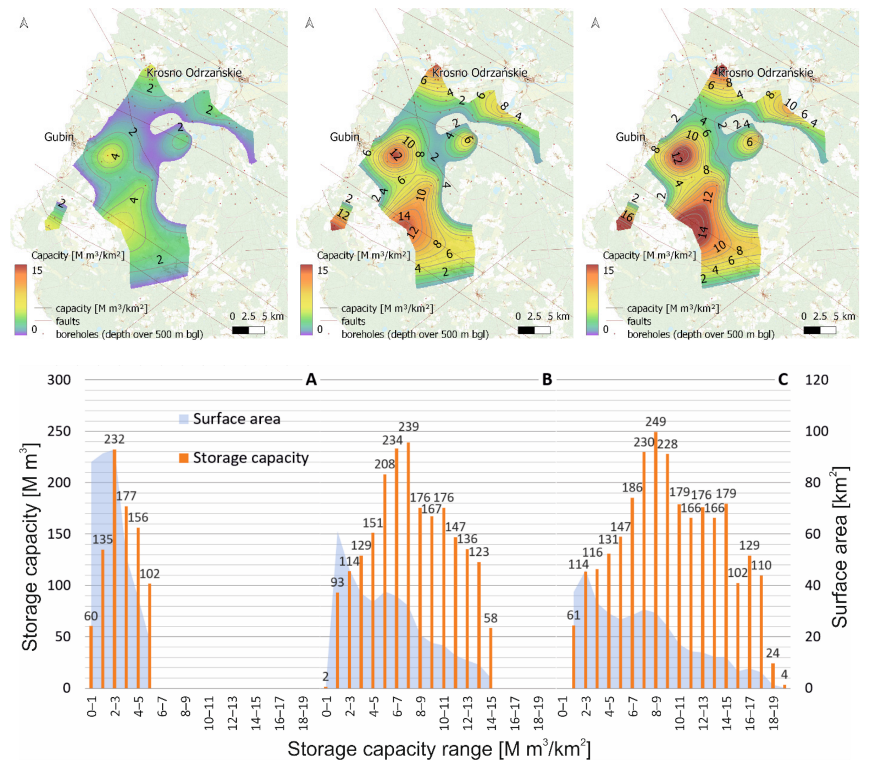
Appendix C.2. The Central Part of the Fore-Sudetic Monocline

References
- Bays, C. Use of salt solution cavities for underground storage. In Proceedings of the First World Salt Symposium; Northern Ohio Geological Society: Cleveland OH, USA, 1963; pp. 564–578. [Google Scholar]
- Kunstman, A.; Poborska-Młynarska, K.; Urbańczyk, K. Geologiczne i górnicze aspekty budowy magazynowych kawern solnych. Przegląd Geol. 2009, 57, 819–828. [Google Scholar]
- Lord, D.; Roberts, B.L.; Gutierrez, K.; Rudeen, D.K. Solution Mining Characteristics of U.S. Strategic Petroleum Reserve Oil Drawdown. In Proceedings of the SMRI Spring 2012 Technical Conference, Regina, SK, Canada, 22–25 April 2012. [Google Scholar]
- Andrews, A.; Pirog, R. The Strategic Petroleum Reserve: Authorization, Operation, and Drawdown Policy; CRS Rep Congr R42460; Congressional Research Service, Library of Congress: Washington, DC, USA, 2012. [Google Scholar]
- Bai, Y.; Dahl, C. Evaluating the management of U.S. Strategic Petroleum Reserve during oil disruptions. Energy Policy 2018, 117, 25–38. [Google Scholar] [CrossRef]
- Istvan, J.H.; Lenz, J.E.; Cook, T.W. Potential for Storage of Natural Gas in the Hutchinson Salt Member of the Wellington Formation of South-Central Kansas. In Proceedings of the SMRI Fall 1998 Meeting; Solution Mining Research Institute: Rome, Italy, 1998. [Google Scholar]
- Ślizowski, J.; Urbańczyk, K.; Łaciak, M.; Lankof, L.; Serbin, K. Efektywność magazynowania gazu ziemnego i wodoru w kawernach solnych. Effectiveness of natural gas and hydrogen storage in salt caverns. Przemysł Chem. 2017, 96, 994–998. [Google Scholar] [CrossRef]
- Parkes, D.; Evans, D.; Williamson, P.; Williams, J. Estimating available salt volume for potential CAES development: A case study using the Northwich Halite of the Cheshire Basin. J. Energy Storage 2018, 18, 50–61. [Google Scholar] [CrossRef]
- Lankof, L.; Tarkowski, R. Assessment of the potential for underground hydrogen storage in bedded salt formation. Int. J. Hydrogen Energy 2020, 45, 19479–19492. [Google Scholar] [CrossRef]
- Caglayan, D.G.; Weber, N.; Heinrichs, H.U.; Linßen, J.; Robinius, M.; Kukla, P.A.; Stolten, D. Technical potential of salt caverns for hydrogen storage in Europe. Int. J. Hydrogen Energy 2020, 45, 6793–6805. [Google Scholar] [CrossRef]
- Kunstman, A.; Urbańczyk, K. Designing of the storage cavern for liquid products, anticipating its size and shape changes during withdrawal operations with use of unsaturated brine. In Proceedings of the SMRI Spring 2008 Technical Conference, Porto, Portugal, 27–30 April 2008. [Google Scholar]
- Urbańczyk, K. Dwa czynniki ograniczające żywotność kawern magazynujących media ciekłe. Two factors limiting the lifetime of the caverns storing liquid media. Przegląd Solny/Salt Rev. 2019, 15, 40–44. [Google Scholar]
- Ratigan, J.L.; Nieland, J.D.; McCauley, T.V. Geomechanical Assessment of the LOOP LLC Crude Oil Storage Facility in the Clovelly Salt Dome, Louisiana. In Proceedings of the SMRI Fall 2006 Conference; Solution Mining Research Institute: Rapid City, SD, USA, 2006. [Google Scholar]
- Ehgartner, B.L.; Park, B.Y. Allowable Pillar to Diameter Ratio for Strategic Petroleum Reserve Caverns; Sandia Report SAND2011-2896; Sandia National Laboratories: Albuquerque, NM, USA; Livermore, CA, USA, 2011. [Google Scholar]
- Zhang, X.-B.; Qin, P.; Chen, X. Strategic oil stockpiling for energy security: The case of China and India. Energy Econ. 2017, 61, 253–260. [Google Scholar] [CrossRef]
- Zhang, N.; Shi, X.; Zhang, Y.; Shan, P. Tightness Analysis of Underground Natural Gas and Oil Storage Caverns with Limit Pillar Widths in Bedded Rock Salt. IEEE Access 2020, 8, 12130–12145. [Google Scholar] [CrossRef]
- Gąska, K.; Hoszowski, A.; Gmiński, Z.; Kurek, A. Monografia Podziemnych Magazynów Gazu; Oficyna Wydawnicza ASPRA-JR: Warszawa, Poland, 2012. [Google Scholar]
- Ślizowski, J.; Urbańczyk, K.; Lankof, L.; Serbin, K. Analiza zmienności polskich pokładów soli kamiennej w aspekcie magazynowania gazu. Wiert Naft. GAZ 2011, 28, 431–443. [Google Scholar]
- Cauberg, H.; Kuilman, B.; Valkering, B.; Walters, J.V. Rock mechanical behavior and sealing aspects of a closed-in salt cavity filled with brine. In Proceedings of the SMRI Fall Meeting; Solution Mining Research Institute: Amsterdam, The Netherlands, 1986. [Google Scholar]
- Habibi, R. An investigation into design concepts, design methods and stability criteria of salt caverns. Oil Gas Sci. Technol.–Rev. d’IFP Energies Nouv. 2019, 74, 14. [Google Scholar] [CrossRef]
- Gniady, C.T.; Ehgartner, B.L. Fracture Predictions for Over-Pressurizationof Sealed Wellbores. In Proceedings of the SMRI Fall 1993 Meeting; Solution Mining Research Institute: Lafayette, LA, USA, 1993. [Google Scholar]
- Wallner, M.; Paar, W.A. Risk of Progressive Pressure Build Up in a Sealed Cavity. In Proceedings of the SMRI Fall 1997 Meeting; Solution Mining Research Institute: El Paso, TX, USA, 1997. [Google Scholar]
- Thoraval, A.; Lahaie, F.; Brouard, B.; Berest, P. A generic model for predicting long-term behavior of storage salt caverns after their abandonment as an aid to risk assessment. Int. J. Rock Mech. Min. Sci. 2015, 77, 44–59. [Google Scholar] [CrossRef]
- Czapowski, G.; Aleksandrowski, P.; Jarosiński, M. Struktury solne 1: 5,000,000. In Atlas Geologiczny Polski; Nawrocki, J., Becker, A., Eds.; PIG–PIB: Warszawa, Poland, 2017; pp. 1–170. [Google Scholar]
- Czapowski, G.; Peryt, T.; Antoniewicz, L. Facies and paleogeography of the Zechstein (Upper Permian) Oldest Halite (Na1) in Poland. Bull. Pol. Acad. Sc. Earth Sci. 1993, 41, 217–227. [Google Scholar]
- Wagner, R.; Peryt, T.M. Possibility of sequence stratigraphic subdivision of the Zechstein in the Polish Basin. Geol. Q. 1997, 41, 457–474. [Google Scholar]
- Deczkowski, Z.; Gajewska, I. Charakterystyka starokimeryjskich i laramijskich struktur blokowych monokliny przedsudeckiej. Kwart Geol. 1997, 23, 467–481. [Google Scholar]
- Sobolik, S.R.; Ehgartner, B.L. Analysis of Simple Cavern Shapes for the Strategic Petroleum Reserve. In Proceedings of the SMRI Fall 2006 Conference; Solution Mining Research Institute: Rapid City, SD, USA, 2006. [Google Scholar]
- Wang, T.; Yan, X.; Yang, H.; Yang, X.; Jiang, T.; Zhao, S. A new shape design method of salt cavern used as underground gas storage. Appl. Energy 2013, 104, 50–61. [Google Scholar] [CrossRef]
- Urbańczyk, K.; Ślizowski, J.; Serbin, K. Prognoza Pojemności Magazynów Płynnych Węglowodorów w Polskich Złożach Soli Kamiennej w Zależności od Warunków Naturalnych i Czynników Górniczo-Technicznych; Raport z Projektu Badawczego Nr N N525 363935; MONEY.PL: Kraków, Poland, 2011. [Google Scholar]
- Zhang, G.; Wu, Y.; Wang, L.; Zhang, K.; Daemen, J.J.; Liu, W. Time-dependent subsidence prediction model and influence factor analysis for underground gas storages in bedded salt formations. Eng. Geol. 2015, 187, 156–169. [Google Scholar] [CrossRef]
- Yang, C.; Wang, T.; Li, J.; Ma, H.; Shi, X.; Daemen, J.J.K. Feasibility analysis of using closely spaced caverns in bedded rock salt for underground gas storage: A case study. Environ. Earth Sci. 2016, 75, 1138. [Google Scholar] [CrossRef]
- Ślizowski, J.; Urbańczyk, K.; Czapowski, G.; Lankof, L.; Serbin, K.; Ślizowski, K. Możliwości Magazynowania Gazu Ziemnego w Polskich Złożach Soli Kamiennej w Zależności od Warunków Geologiczno-Górniczych; Śślizowski, J., Urbańczyk, K., Eds.; Wydawnictwo IGSMiE PAN: Kraków, Poland, 2011; 132p. [Google Scholar]
- Bérest, P.; Brouard, B. A tentative classification of salts according to their creep properties. In Proceedings of the SMRI Spring 1998 Meeting; Solution Mining Research Institute: New Orleans, LO, USA, 1998; pp. 1–21. [Google Scholar]
- Xing, W.; Zhao, J.; Hou, Z.; Were, P.; Li, M.; Wang, G. Horizontal natural gas caverns in thin-bedded rock salt formations. Environ. Earth Sci. 2015, 73, 6973–6985. [Google Scholar] [CrossRef]
- Mortazavi, A.; Nasab, H. Analysis of the behavior of large underground oil storage caverns in salt rock. Int. J. Numer. Anal. Methods Géoméch. 2016, 41, 602–624. [Google Scholar] [CrossRef]
- Ban, F.; Yuan, G.; Wan, J.; Peng, T. The optimum interwell distance analysis of two-well-horizontal salt cavern construction. Energy Sources Part A Recover. Util. Environ. Eff. 2020, 43, 3082–3100. [Google Scholar] [CrossRef]
- Wang, T.; Ma, H.; Shi, X.; Yang, C.; Zhang, N.; Li, J.; Ding, S.; Daemen, J. Salt cavern gas storage in an ultra-deep formation in Hubei, China. Int. J. Rock Mech. Min. Sci. 2018, 102, 57–70. [Google Scholar] [CrossRef]
- Zhang, N.; Ma, L.; Wang, M.; Zhang, Q.; Li, J.; Fan, P. Comprehensive risk evaluation of underground energy storage caverns in bedded rock salt. J. Loss Prev. Process Ind. 2017, 45, 264–276. [Google Scholar] [CrossRef]
- Wang, G.; Guo, K.; Christianson, M.; Konietzky, H. Deformation characteristics of rock salt with mudstone interbeds surrounding gas and oil storage cavern. Int. J. Rock Mech. Min. Sci. 2011, 48, 871–877. [Google Scholar] [CrossRef]
- Serbin, K.; Ślizowski, J.; Urbańczyk, K.; Nagy, S. The influence of thermodynamic effects on gas storage cavern convergence. Int. J. Rock Mech. Min. Sci. 2015, 79, 166–171. [Google Scholar] [CrossRef]
- Urbańczyk, K. Ługowanie w złożach małej miąższości (Proces ługowania kawern solnych cz. V) Leaching in thin-bedded deposits. (Salt cavern leaching process p. V). Przegląd Solny/Salt Rev. 2021, 27, 67–91. [Google Scholar]
- Ślizowski, J.; Lankof, L.; Urbańczyk, K.; Serbin, K. Potential capacity of gas storage caverns in rock salt bedded deposits in Poland. J. Nat. Gas Sci. Eng. 2017, 43, 167–178. [Google Scholar] [CrossRef]
- Scafidi, J.; Wilkinson, M.; Gilfillan, S.M.; Heinemann, N.; Haszeldine, R.S. A quantitative assessment of the hydrogen storage capacity of the UK continental shelf. Int. J. Hydrogen Energy 2021, 46, 8629–8639. [Google Scholar] [CrossRef]
- Evans, D.; Parkes, D.; Dooner, M.; Williamson, P.; Williams, J.; Busby, J.; He, W.; Wang, J.; Garvey, S. Salt Cavern Exergy Storage Capacity Potential of UK Massively Bedded Halites, Using Compressed Air Energy Storage (CAES). Appl. Sci. 2021, 11, 4728. [Google Scholar] [CrossRef]
- Lux, K.-H. Design of salt caverns for the storage of natural gas, crude oil and compressed air: Geomechanical aspects of construction, operation and abandonment. Geol. Soc. Lond. Spéc. Publ. 2009, 313, 93–128. [Google Scholar] [CrossRef]
- Qiu, Y.; Zhou, S.; Wang, J.; Chou, J.; Fang, Y.; Pan, G.; Gu, W. Feasibility analysis of utilising underground hydrogen storage facilities in integrated energy system: Case studies in China. Appl. Energy 2020, 269, 115140. [Google Scholar] [CrossRef]
- Wu, G.; Wei, Y.-M.; Nielsen, C.; Lu, X.; McElroy, M.B. A dynamic programming model of China’s strategic petroleum reserve: General strategy and the effect of emergencies. Energy Econ. 2012, 34, 1234–1243. [Google Scholar] [CrossRef]
- Shi, X.; Liu, W.; Chen, J.; Yang, C.; Li, Y.; Ma, H.; Peng, H.; Wang, T.; Ma, X. Geological Feasibility of Underground Oil Storage in Jintan Salt Mine of China. Adv. Mater. Sci. Eng. 2017, 2017, 1–11. [Google Scholar] [CrossRef] [Green Version]
- Rath, R.; Nanda, A.; Wippich, M.; Wilke, H.F. Underground Salt Cavern Storages for Crude Oil at Bikaner, India. In Proceedings of the SMRI Fall 2014 Technical Conference, Groningen, Chester, UK, 28 September–1 October 2014. [Google Scholar]

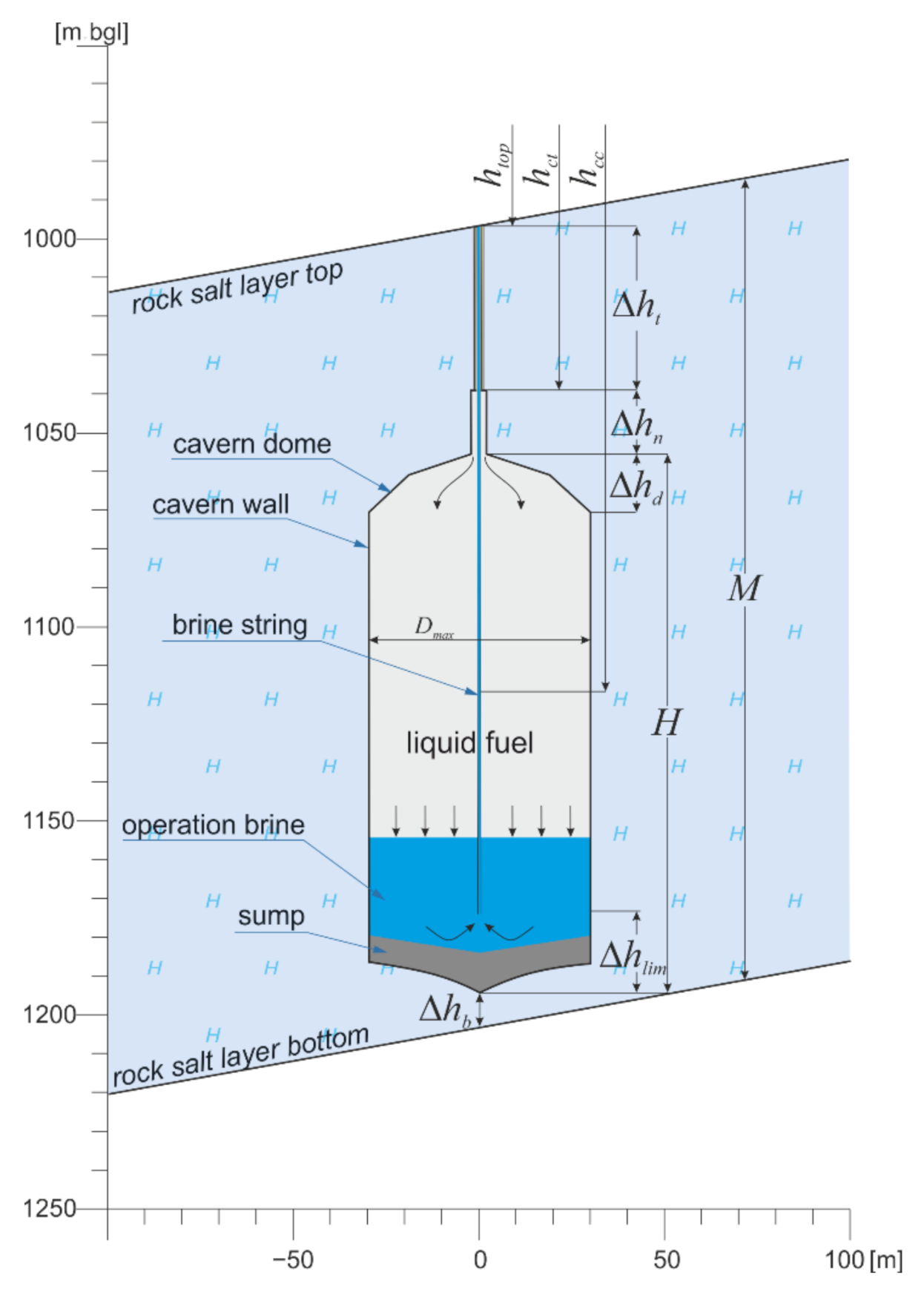
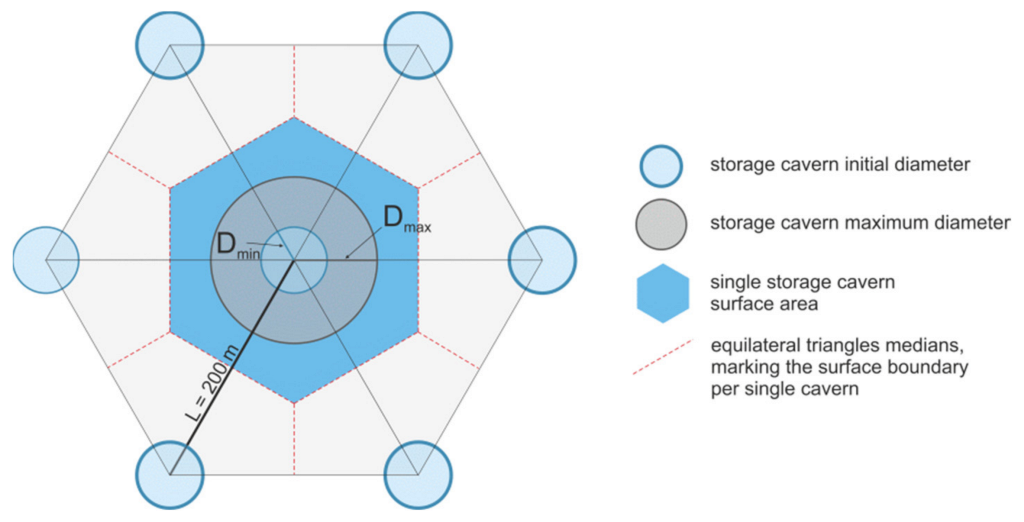

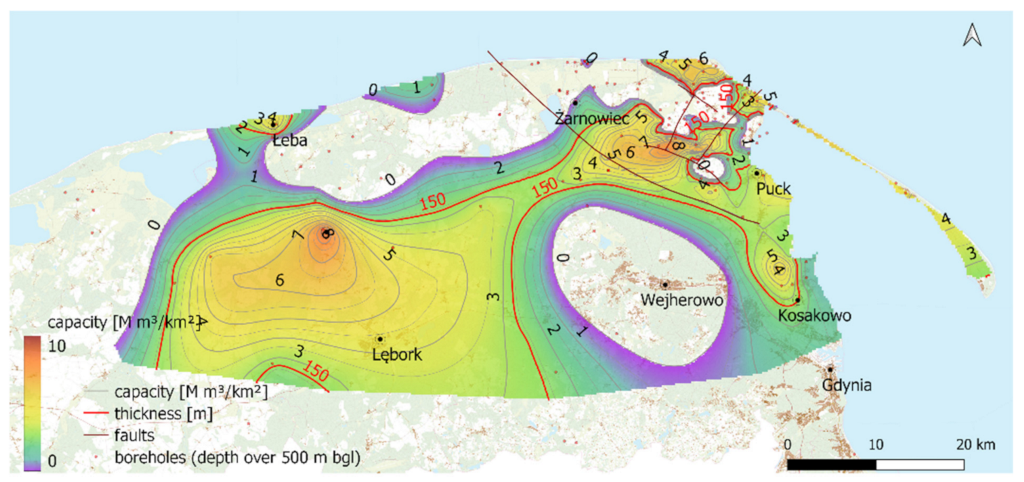
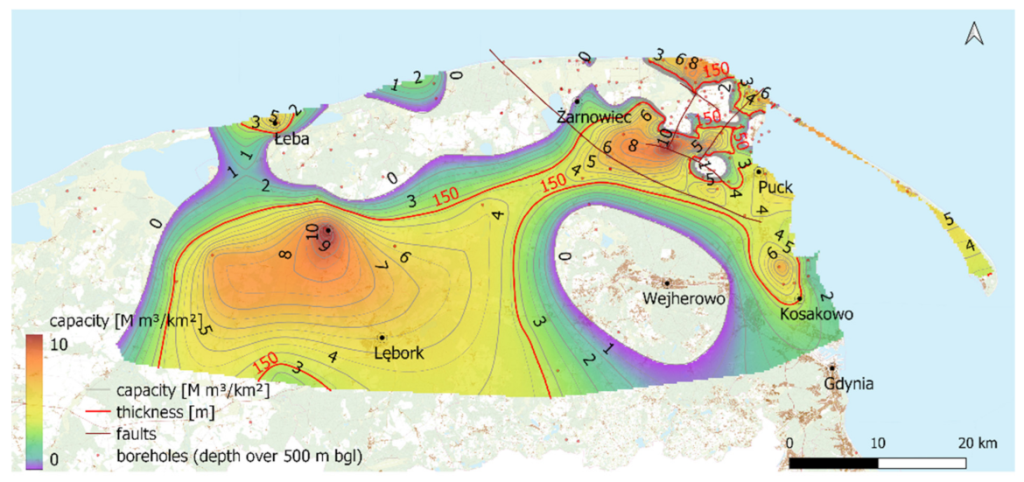
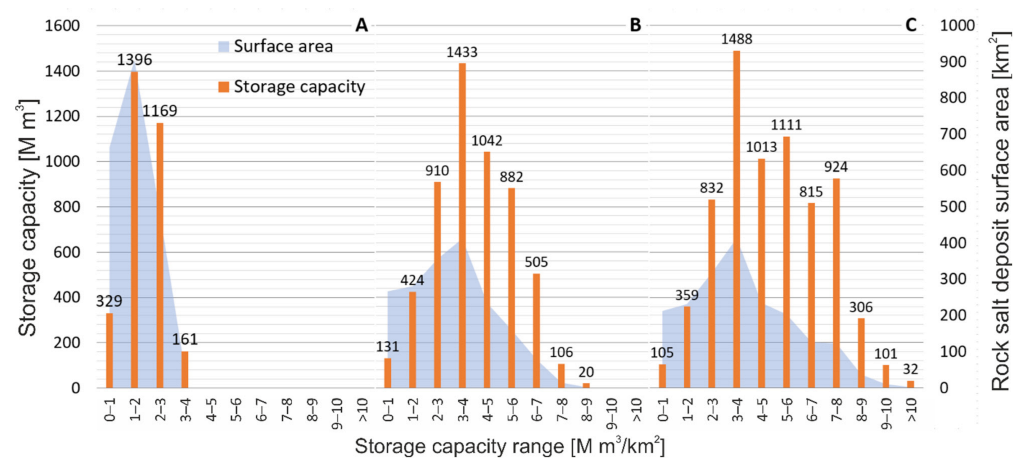
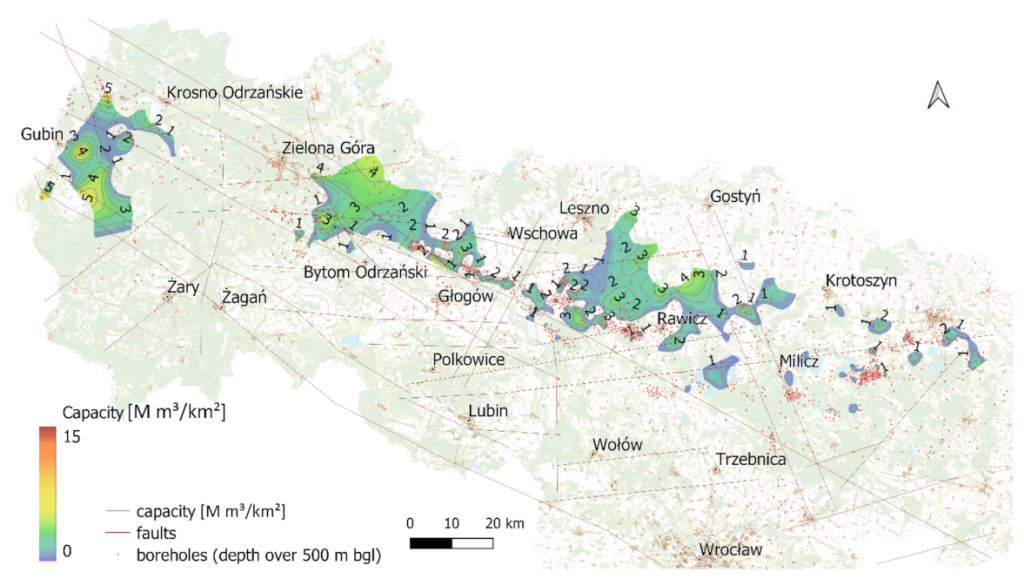

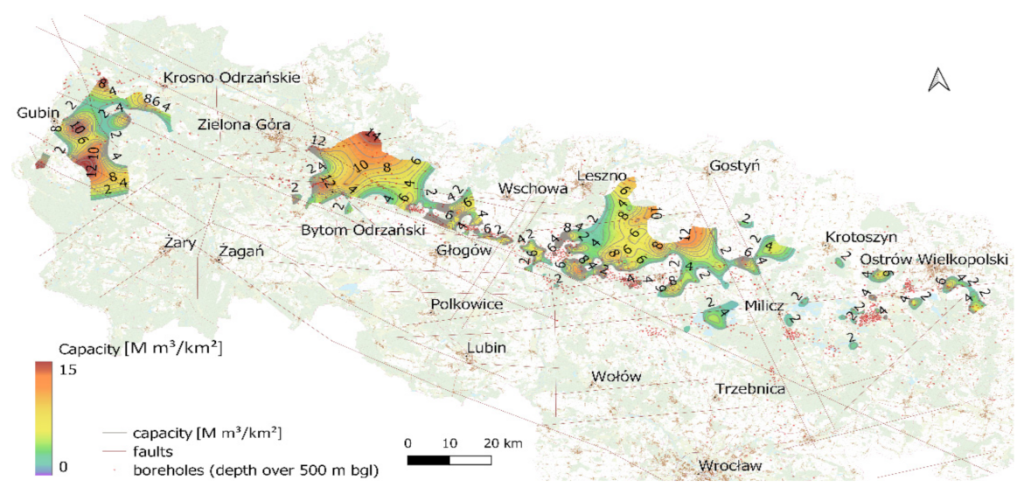
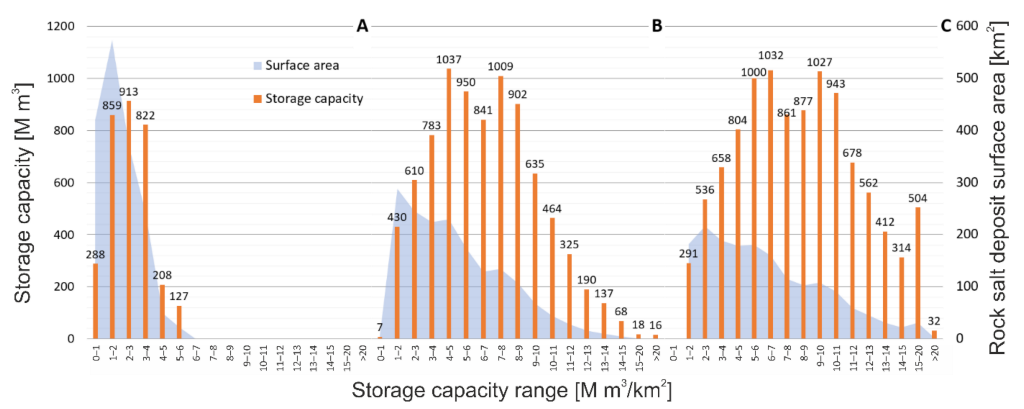
Publisher’s Note: MDPI stays neutral with regard to jurisdictional claims in published maps and institutional affiliations. |
© 2022 by the authors. Licensee MDPI, Basel, Switzerland. This article is an open access article distributed under the terms and conditions of the Creative Commons Attribution (CC BY) license (https://creativecommons.org/licenses/by/4.0/).
Share and Cite
Lankof, L.; Nagy, S.; Polański, K.; Urbańczyk, K. Potential for Underground Storage of Liquid Fuels in Bedded Rock Salt Formations in Poland. Energies 2022, 15, 7005. https://doi.org/10.3390/en15197005
Lankof L, Nagy S, Polański K, Urbańczyk K. Potential for Underground Storage of Liquid Fuels in Bedded Rock Salt Formations in Poland. Energies. 2022; 15(19):7005. https://doi.org/10.3390/en15197005
Chicago/Turabian StyleLankof, Leszek, Stanisław Nagy, Krzysztof Polański, and Kazimierz Urbańczyk. 2022. "Potential for Underground Storage of Liquid Fuels in Bedded Rock Salt Formations in Poland" Energies 15, no. 19: 7005. https://doi.org/10.3390/en15197005







